Overview
Creating a meal plan for diabetes is a journey that involves incorporating balanced meals focused on whole grains, lean proteins, healthy fats, and high-fiber foods. These elements are essential for effectively managing blood sugar levels.
It's understandable to feel overwhelmed by this process, but structured meal planning can be a powerful tool. Not only does it aid in portion control and carbohydrate management, but it also empowers you by promoting healthier choices and overall well-being.
Remember, you're not alone in this journey. We are here to support you every step of the way.
Introduction
In the intricate landscape of diabetes management, meal planning stands out as a vital strategy for maintaining stable blood sugar levels and fostering overall health. It's understandable to feel overwhelmed by dietary choices, but understanding the significance of balanced nutrition can empower you. With various dietary patterns and practical strategies available, you can take control of your health and make informed decisions that align with your unique needs.
From exploring nutritious recipes to mastering portion control, this article delves into the essential components of effective meal planning for diabetes. We are here to support you every step of the way, providing insights and resources to help you embrace a healthier lifestyle. Remember, you're not alone in this journey; together, we can navigate the path to better health.
Understanding the Importance of Meal Planning for Diabetes
Meal planning is an essential approach for effectively managing blood sugar levels, especially in 2025. A thoughtful meal plan for diabetes plays a crucial role in maintaining stability. By ensuring that dishes are balanced and nutritious, individuals can significantly reduce the risk of glucose spikes that often result from impulsive food choices. This proactive method not only helps improve regulation of portion sizes and carbohydrate consumption but also supports overall health management.
Studies show that organized eating habits are vital for sustaining a healthy weight, which is essential for lowering the risk of issues related to blood sugar conditions. For instance, a case study on the Mediterranean-style dietary pattern highlights its benefits for individuals managing diabetes. This dietary approach emphasizes the intake of:
- Whole grains
- Fruits
- Vegetables
- Healthy fats (like olive oil)
- Lean proteins
These elements have been proven to reduce A1C levels and enhance cardiovascular fitness, making it a recommended option for those aiming to improve their overall well-being.
However, it's important to acknowledge that the study faced limitations, including a small sample size of 40 participants and a short duration of just 2 weeks. This suggests the need for future research with larger groups and longer study periods.
The significance of a meal plan for diabetes is further underscored by statistics indicating that the average overall nutritional score among individuals who engage in meal planning is 63 points. This score reflects the positive impact of dietary interventions on blood sugar control and overall health outcomes. Experts stress that examining the impacts of dietary guidelines is essential for confirming their efficacy in managing blood sugar conditions.
As Robert H. Shmerling, MD, states, "Studying the impact of dietary (or any other) recommendations is an important way to validate the guidelines’ usefulness."
Integrating a meal plan for diabetes into everyday practices not only assists in blood sugar regulation but also fosters a sense of empowerment among individuals managing the condition. By taking charge of their dietary choices, they can create a sustainable and health-focused lifestyle that promotes long-term well-being. Remember, you're not alone in this journey; we are here to support you every step of the way.

Key Components of a Diabetes Meal Plan
Creating a diabetes meal plan can feel overwhelming, but it doesn’t have to be. A well-structured plan should include several key components that not only help manage blood sugar levels but also promote your overall health.
-
Carbohydrates are an essential part of your diet. Focus on complex carbohydrates like whole grains, legumes, and a variety of vegetables. These foods usually have a lower glycemic index, which helps keep your blood sugar stable and provides you with lasting energy throughout the day.
-
Proteins are equally important. Incorporate lean sources such as chicken, fish, tofu, and legumes. These proteins are vital for maintaining your muscle mass and can help you feel full, which is crucial for managing your weight—a key aspect of your health journey.
-
When it comes to fats, choose healthy options found in avocados, nuts, and olive oil. It’s wise to limit saturated and trans fats, as they can negatively impact your heart health, which is particularly important if you’re managing blood sugar issues.
-
Don’t forget about fiber! Including high-fiber foods like fruits, vegetables, and whole grains is essential. Fiber helps manage blood sugar levels and supports digestive health, making it a cornerstone of your meal plan.
-
Hydration is often overlooked, but maintaining adequate fluid intake—primarily through water—is crucial for your metabolic processes and overall health. If you choose to drink alcohol, moderation is key: no more than one drink per day for women and two for men.
-
It’s also important to consider the recommended carbohydrate intake for blood sugar control. Current guidelines suggest that carbohydrates should account for about 45-60% of your total daily calories. This balance is vital for your health.
Recent studies underscore the importance of personalized nutrition strategies in managing diabetes. For example, the case study titled "Unmet Nutritional Needs in Type 2 Diabetes Management" highlights that addressing unmet needs—like weight control and psychological support—can significantly improve outcomes. Tailoring your dietary plan to your preferences and health needs, including possible vitamin and mineral supplementation, can enhance adherence and overall well-being.
Technology can also be a great ally in your journey. Mobile apps and wearable devices can assist with weight management by tracking your calorie intake and physical activity, making it easier to stick to your dietary plan.
By focusing on these essential elements and incorporating insights from professionals, including the American Diabetes Association, you can create a meal plan that not only helps regulate your blood sugar but also encourages a healthier lifestyle. Remember, while fad diets may promise quick results, it’s more important to choose foods you can sustain over time.
Lastly, be mindful of dietary sodium. Excessive restriction can lead to hyponatremia, which may reduce insulin sensitivity and increase the risk of prediabetes.
At T2DSolutions, we are here to support you on your journey with Type 2 diabetes. Subscribe to our updates to stay informed about new content and resources that can assist you in managing your health effectively. You're not alone in this journey, and together, we can navigate these challenges.
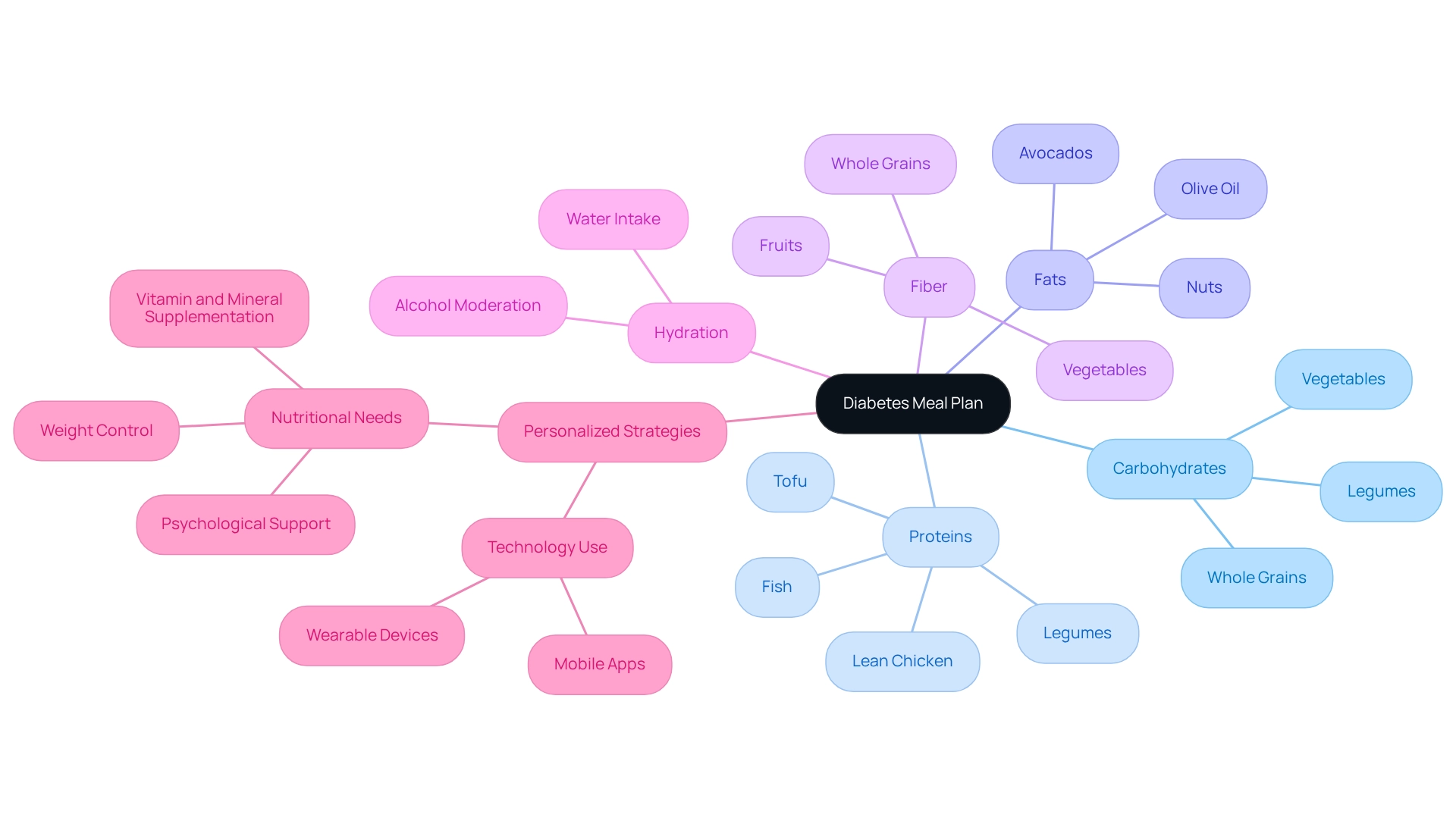
Practical Strategies for Effective Meal Planning
Creating a meal plan for diabetes can feel overwhelming, but with the right strategies, it can simplify your daily routine and enhance your health outcomes. At T2DSolutions, we understand the challenges you face and are committed to providing the resources and support you need to navigate your dietary needs.
-
Plan Ahead: Setting aside time each week to outline your meals and snacks can make a significant difference. Using a calendar or a food planning application can help you stay organized and dedicated to your dietary objectives. Remember, you're not alone in this journey.
-
Batch Cooking: Preparing larger quantities of dishes and freezing portions for later use can be a game-changer. This approach not only saves time but also ensures you have healthy, diabetes-friendly options readily available. Many individuals who engage in batch cooking find they comply better with their dietary plans, leading to improved blood sugar regulation. For instance, a study revealed a significant reduction in the mean glycemic excursion amplitude when participants consumed a snack during the research, highlighting the importance of timing and planning in food intake.
-
Utilize a Grocery List: Creating a shopping list based on your meal plan can help reduce impulse purchases and ensure you have all the essential ingredients on hand. This practice supports your dietary goals and helps you avoid unhealthy choices. It's understandable to feel tempted, but having a list can guide you.
-
Incorporate Variety: To keep your meals interesting and nutritionally balanced, try rotating different recipes and ingredients. This not only prevents boredom but also ensures you receive a wide range of essential nutrients, which is crucial for overall health. The DASH diet, significantly lower in sodium than the typical American diet, has been shown in large, randomized trials to reduce blood pressure, underscoring the importance of a balanced diet in diabetes management.
-
Stay Flexible: Life can be unpredictable, so allow for adjustments in your food plan to accommodate unexpected events or cravings. Flexibility is key to maintaining a sustainable diet while adhering to your overall dietary goals. Consistent fish intake might aid in lowering triglycerides by replacing items with higher saturated and trans fats, which can be beneficial for your dining arrangements.
By implementing these strategies, you can create a meal plan for diabetes that not only supports your management but also enhances your overall quality of life. T2DSolutions is here to help you regularly review and modify your dietary plan based on your experiences and preferences, guiding you toward long-term success. As Imai S. noted, "The study revealed a significant reduction in the mean glycemic excursion amplitude, as well as a decrease in postprandial serum glucose after dinner in the subjects who consumed the snack during this study," reinforcing the importance of mindful eating and meal planning. Remember, we are here to support you every step of the way.
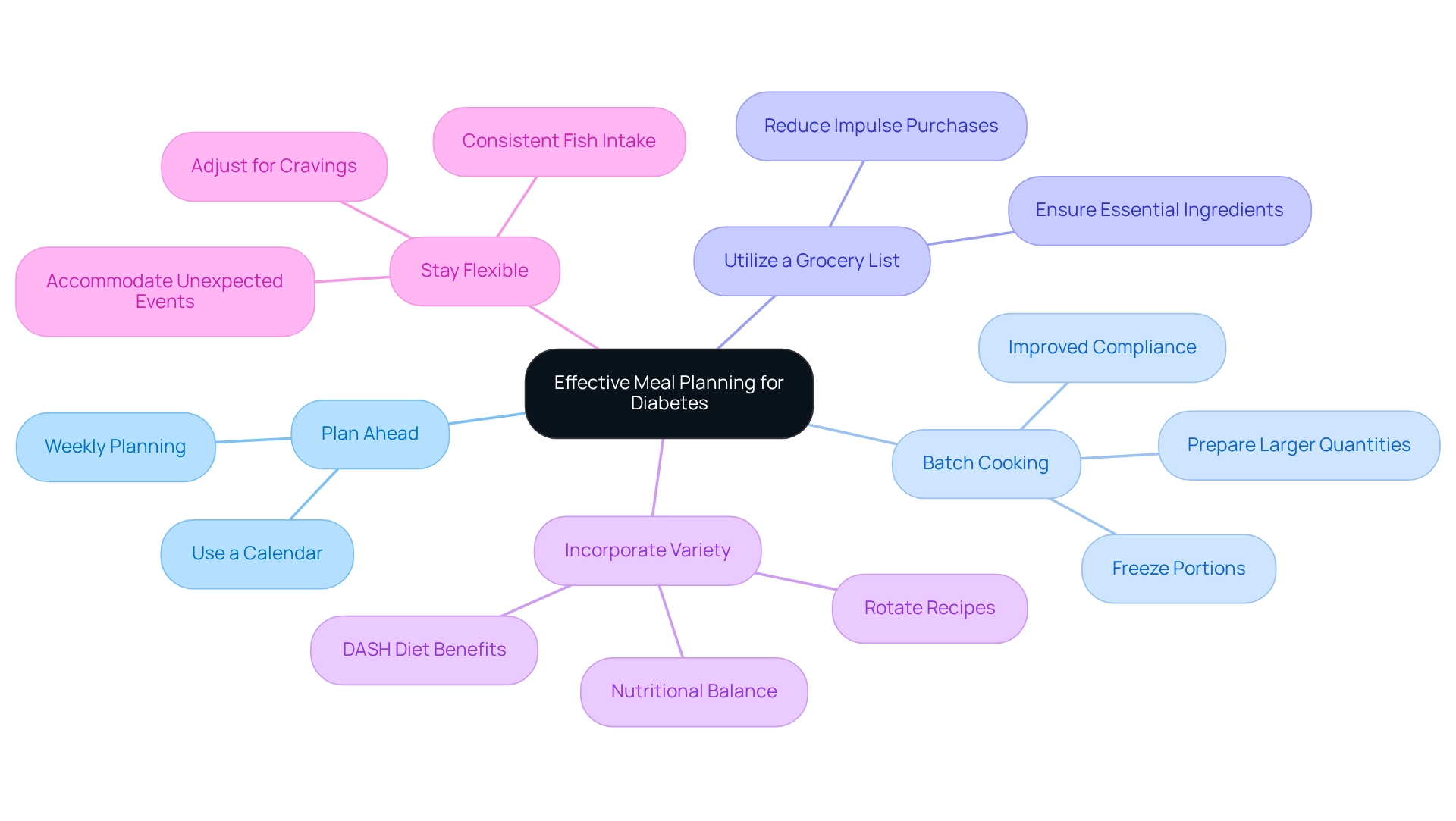
Exploring Dietary Patterns for Diabetes Management
Managing blood sugar levels can feel overwhelming, but there are numerous dietary patterns that can effectively assist you on this journey, each offering unique advantages.
-
Mediterranean Diet: Emphasizing whole grains, fruits, vegetables, healthy fats, and lean proteins, this diet has been shown to improve glycemic control and cardiovascular health. Research highlights that a diet rich in plant foods, while minimizing animal-derived products, significantly lowers the risk of diabetes-related complications. This insight aligns with findings from the case study titled 'Determining Dietary Patterns to Recommend for Type 2 Diabetes,' which synthesizes existing research to provide clear dietary guidelines. You're not alone in seeking a path to better health through nutrition.
-
DASH Diet: Originally designed to combat hypertension, the DASH (Dietary Approaches to Stop Hypertension) diet focuses on reducing sodium intake while promoting a variety of fruits, vegetables, whole grains, and low-fat dairy. This dietary approach not only aids in controlling blood pressure but also enhances overall well-being, making it a beneficial choice for those managing diabetes.
-
Plant-Based Diet: Incorporating a diverse array of plant foods—such as vegetables, fruits, legumes, nuts, and seeds—can significantly improve insulin sensitivity and reduce inflammation. Research underscores the importance of plant foods in managing blood sugar, making this an appealing option for individuals aiming to enhance their health through nutrition.
-
Low-Carbohydrate Diet: By limiting carbohydrate intake, this diet helps control blood sugar levels. While it can be beneficial for some, it’s essential to tailor this approach to meet your individual needs and preferences, ensuring it remains sustainable and effective.
The collective impact of these dietary patterns on diabetes management is significant. Studies indicate that dietary choices can account for approximately 43.56% of effective management strategies. As Ioanna Mavrotsoupakis, an Accredited Practising Dietitian, noted, 'Article acquisition, searches and quality review were supported by Ioanna Mavrotsoupakis.' Understanding and implementing a meal plan for diabetes can empower you to make informed choices that enhance your health and well-being. Remember, you are not alone in this journey; we are here to support you every step of the way.
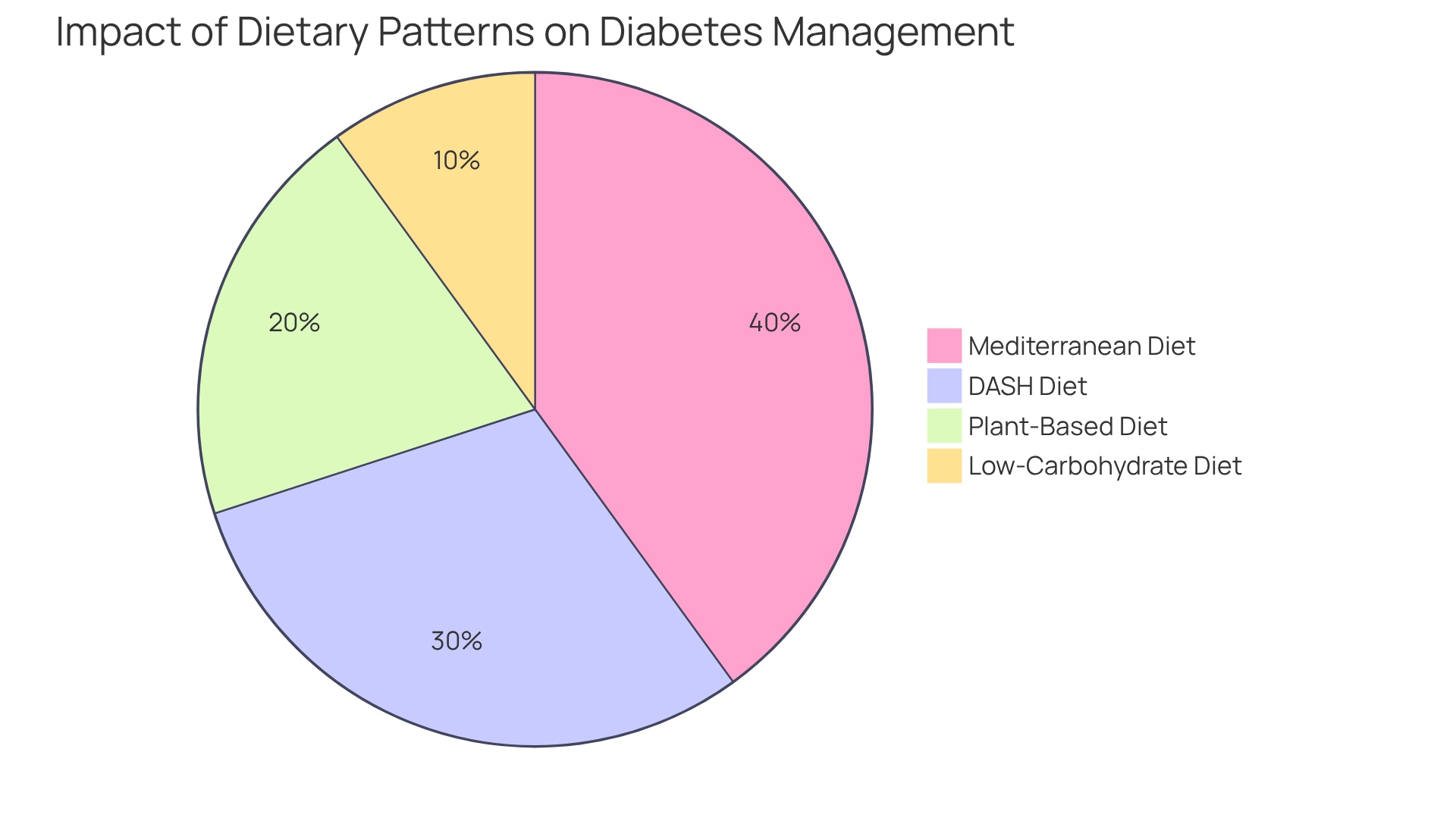
Mastering Portion Control and Carbohydrate Counting
To effectively manage blood sugar levels, mastering portion control and carbohydrate counting is essential.
Portion Control: Using smaller plates and bowls can significantly help in managing portion sizes. Familiarizing yourself with standard serving sizes and employing measuring cups or a food scale when necessary can further enhance accuracy in portioning.
Carbohydrate Counting: Understanding the carbohydrate content in various foods is crucial. Aim for regular carbohydrate consumption at each meal to help develop a meal plan for diabetes that stabilizes blood sugar levels. Generally, it is recommended to include about 45-60 grams of carbohydrates per meal, although individual needs may vary.
Visual Cues: Implement the plate method as a practical visual guide: fill half your plate with non-starchy vegetables, one-quarter with lean protein, and one-quarter with carbohydrates. This approach simplifies portion control and helps maintain balanced meals.
Expert Advice on Portion Control: Experts emphasize that portion control is not just about reducing food intake but also about understanding the nutritional value of what you eat. This knowledge empowers you to make healthier choices without feeling deprived.
Statistics on Portion Control: Research suggests that effective portion control can lead to better blood sugar regulation. For instance, individuals who practice portion control report improved satiety levels and reduced cravings, which are critical for maintaining stable glucose levels. It's concerning to note that in the years 2017-2018, there were 5,293 newly identified cases of type 2 diabetes among children and adolescents aged 10 to 19, highlighting the urgent need for effective management strategies.
Carbohydrate Counting Methods: Various methods exist for counting carbohydrates, including using food labels, carbohydrate counting apps, or consulting with a registered dietitian. Each method can provide valuable insights into managing carbohydrate intake effectively.
Successful Portion Control Strategies: Real-life examples show that individuals who adopt portion control strategies, such as pre-portioning meals or using visual aids, often experience better health outcomes. These strategies not only assist in controlling blood sugar levels but are also essential components of a meal plan for diabetes that enhances overall well-being.
Dietary Considerations: The American Diabetes Association advises moderation in alcohol intake, emphasizing that there is no safe level of alcohol consumption for individuals with the condition. This guideline is crucial for dietary strategies and should be considered when developing a meal plan for diabetes.
Economic Impact of the Condition: The total direct and indirect estimated costs of diagnosed illness in the United States reached $413 billion in 2022. This economic burden highlights the significance of efficient management programs and preventive actions, including portion control and carbohydrate counting, to reduce financial pressure on individuals and the healthcare system.
By incorporating these techniques into your daily routine, you can make substantial progress toward effective management, ultimately resulting in better health outcomes. Remember, you're not alone in this journey. For additional resources and assistance, visit T2DSolutions, your all-inclusive center for education and community support concerning blood sugar management. Subscribe to stay informed about new content and strategies that can assist you in managing your condition effectively.
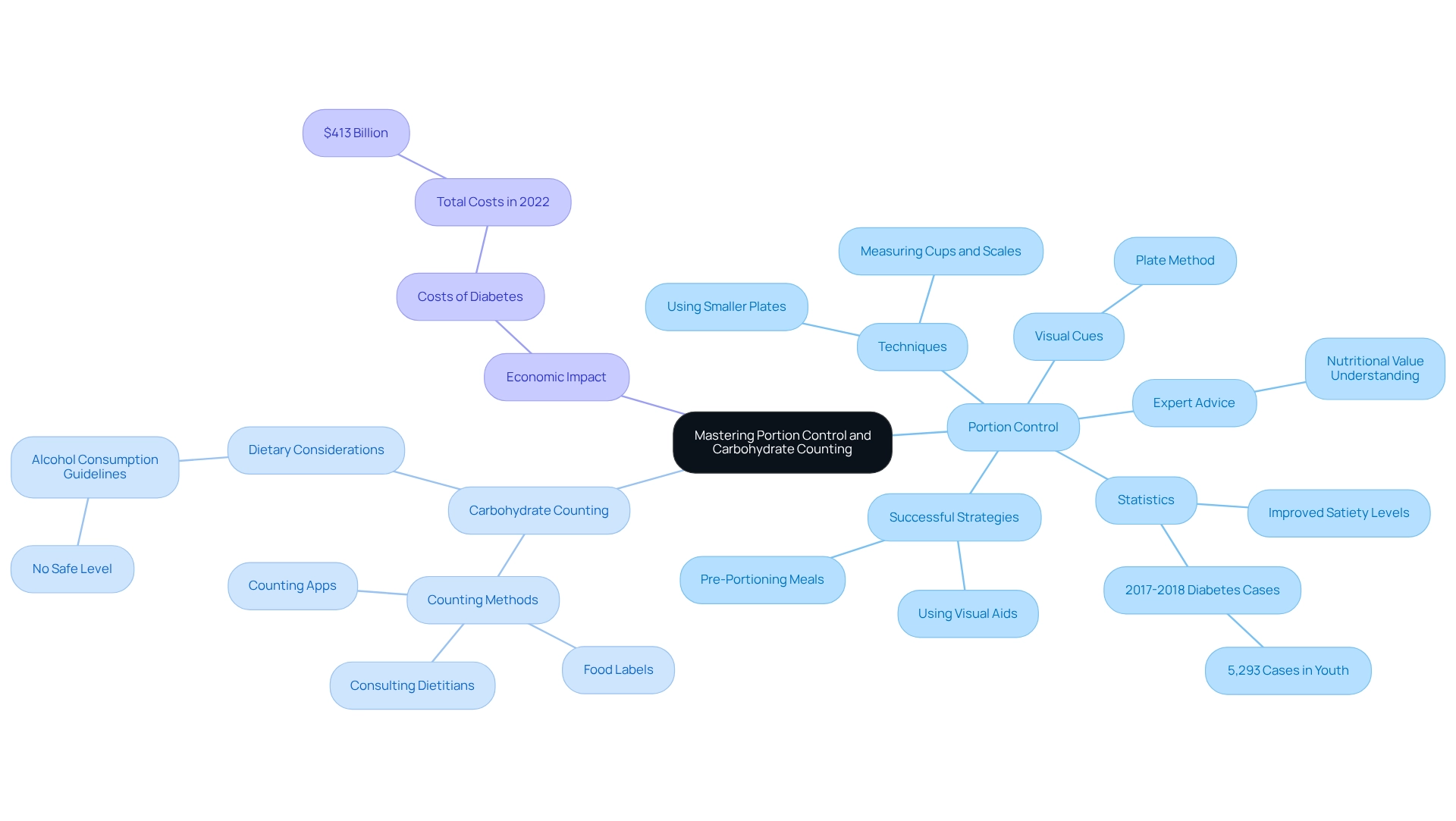
Healthy Recipes for Your Diabetes Meal Plan
Including nutritious recipes in your dietary plan is crucial for effective control, and it’s understandable to seek guidance on this journey. Here are some nutritious options to consider that can make a positive impact on your health:
-
Quinoa Salad with Vegetables: This delightful dish combines cooked quinoa with diced cucumbers, tomatoes, and bell peppers, all drizzled with a lemon-olive oil dressing. Quinoa is especially advantageous for managing blood sugar levels due to its high fiber content, which assists in regulating glucose. It’s a simple yet satisfying choice that you can enjoy.
-
Baked Salmon with Asparagus: Season salmon fillets with herbs and bake them alongside asparagus. This dish is abundant in omega-3 fatty acids, which have been shown to decrease inflammation and enhance cardiovascular well-being. It’s a superb option for individuals controlling diabetes, offering both flavor and health benefits.
-
Chickpea Stir-Fry: Sauté chickpeas with a mix of vibrant vegetables and spices for a quick, enjoyable dish. Chickpeas are a great source of protein and fiber, contributing to prolonged satiety and stable blood sugar levels. This recipe is not only nourishing but also easy to prepare, helping you feel fulfilled.
-
Overnight Oats: Combine rolled oats with almond milk, chia seeds, and berries for a nutritious breakfast. This dish is not only easy to prepare but also rich in fiber and antioxidants, which are advantageous for overall well-being. It’s a comforting start to your day, making mornings a little brighter.
-
Vegetable Soup: Prepare a hearty vegetable soup using low-sodium broth and a variety of vegetables, seasoned with herbs for flavor. Non-starchy vegetables like broccoli, carrots, and cauliflower should fill half of your plate, providing essential nutrients without excessive calories and carbohydrates. Studies indicate that these vegetables enhance satiety, making them a vital component of a diabetes-friendly diet. As T2DSolutions states, "These vegetables keep you feeling full for longer and provide you with the great-tasting nutrients your body needs without as many calories and carbs." Including non-starchy vegetables in your dishes not only aids in feeling satisfied but also promotes your general well-being.
By incorporating these recipes into a meal plan for diabetes, you can enjoy tasty, nutritious dishes that promote your health and well-being while effectively managing blood sugar levels. Remember, you're not alone in this journey, and these delicious options can support you every step of the way.

Building a Supportive Community for Diabetes Management
Creating a supportive community is crucial for effectively managing this condition. Engaging with others who share similar experiences can significantly enhance your journey. Here are several ways to connect with supportive networks through T2DSolutions:
- Join Support Groups: Seek out local or online support groups for those living with the condition. Here, you can share your experiences and learn from others. T2Solutions offers a platform for connecting with these groups, providing a safe space for discussing challenges and successes, fostering a sense of belonging.
- Engage with Healthcare Providers: Collaborate closely with your medical team, including dietitians and educators on blood sugar management. They can offer tailored guidance and support, helping you navigate your management plan effectively. T2Solutions can help you find qualified professionals in your area.
- Participate in Community Events: Attend awareness events, workshops, or health fairs organized by T2Solutions. These gatherings not only offer valuable information but also enable you to meet others who are handling blood sugar issues, creating opportunities for connection and support.
- Utilize Online Resources: Explore online forums and social media groups focused on blood sugar control through T2Solutions. These platforms can be invaluable for finding additional support, sharing tips, and accessing a wealth of information from fellow patients and experts.
- Share Your Journey: Consider sharing your experiences with friends and family. This transparency can promote comprehension and assistance, making your health journey less isolating.
The effect of community support on managing diabetes-related health issues is profound. Research shows that people who participate in support groups frequently encounter enhanced self-care practices and improved well-being results. For instance, a meta-analysis of nine intervention trials found that literacy-sensitive interventions were associated with a statistically significant decrease in HbA1c levels by –0.18% compared to usual clinical care.
Additionally, a recent study on the Community and Peer Support Based Healthy Lifestyle Program (CP-HELP) demonstrated significant improvements in self-care behaviors and reductions in fasting blood glucose levels among participants who received community support compared to those who did not. Wahyu Sukma Samudera noted that "CP-HELP may be a promising interventional strategy to improve self-care behavior and fasting blood glucose in patients with T2DM." This underscores the essential role that community involvement has in managing the condition effectively.
In 2025, the significance of community support remains emphasized by new evidence indicating that creative care models linking clinical and community partners can improve management of blood sugar conditions and advance equity in wellness. By actively seeking out and participating in supportive communities through T2Solutions, you can empower yourself and improve your overall health outcomes. Remember, you're not alone in this journey. Don't forget to subscribe to T2Solutions for updates and resources tailored to your diabetes management journey.
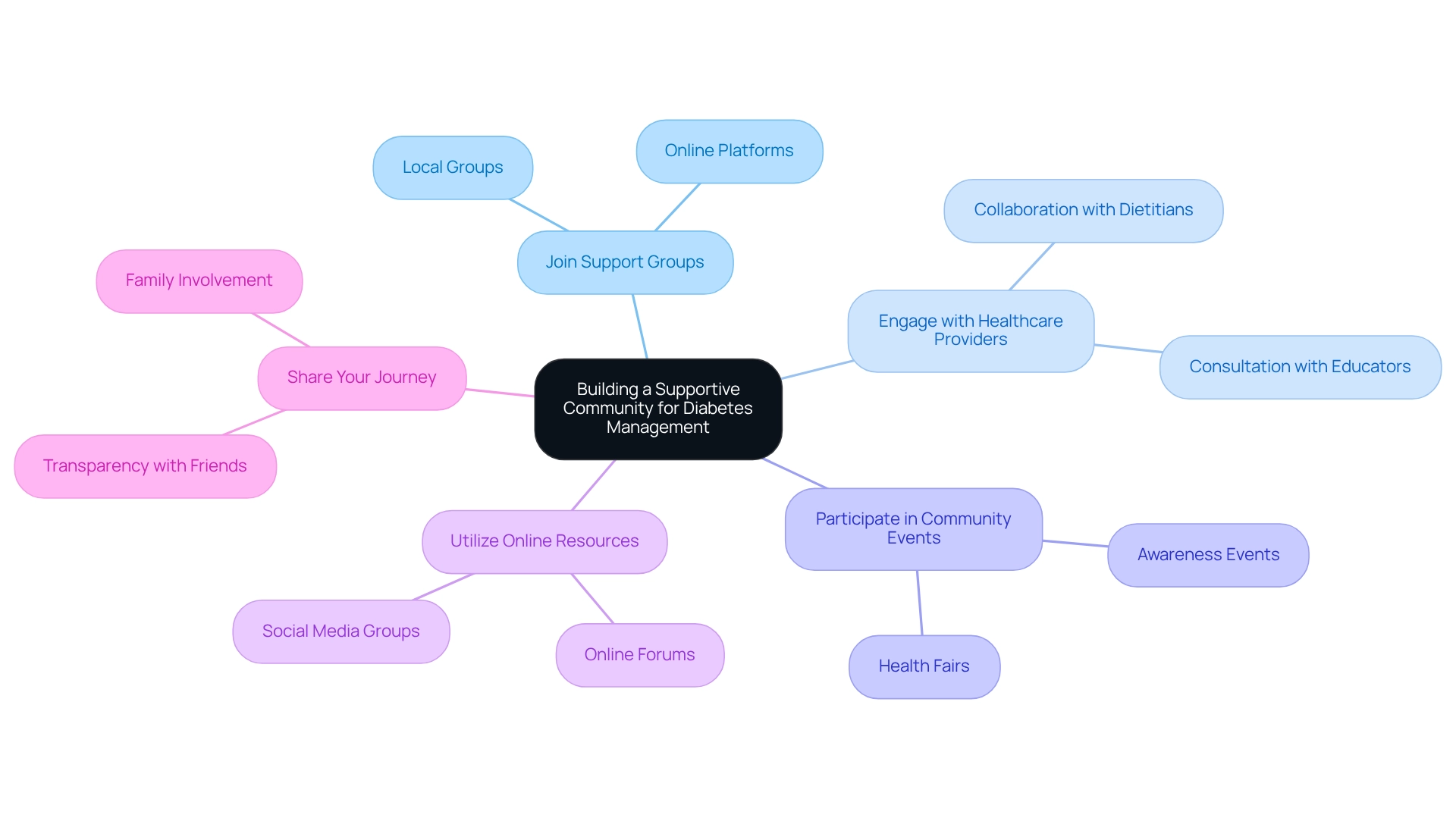
Conclusion
Meal planning serves as a cornerstone for effective diabetes management, offering a structured approach to maintaining stable blood sugar levels and promoting overall well-being. By prioritizing balanced meals that include complex carbohydrates, lean proteins, healthy fats, and fiber, you can significantly enhance your dietary choices and reduce the risk of glucose fluctuations. Incorporating practical strategies such as planning ahead, batch cooking, and utilizing grocery lists not only simplifies your daily routines but also empowers you to take control of your health.
Exploring various dietary patterns—like the Mediterranean diet, DASH diet, and plant-based options—reveals their effectiveness in managing diabetes and improving health outcomes. Mastering portion control and carbohydrate counting can further aid in achieving optimal blood sugar stability, highlighting the importance of mindful eating and informed dietary decisions. Delicious recipes, such as quinoa salad and baked salmon, align perfectly with diabetes management goals.
Building a supportive community is equally crucial. Shared experiences and encouragement can lead to improved self-care behaviors and health outcomes. By engaging with support groups, healthcare providers, and online resources, you can foster connections that enhance your diabetes management journey.
In summary, embracing meal planning and a supportive network not only facilitates effective diabetes management but also fosters a healthier lifestyle. Remember, the path to better health is within reach. With informed choices and community support, you can navigate your journey with confidence and resilience. You're not alone in this journey; we are here to support you every step of the way.
Frequently Asked Questions
Why is meal planning important for managing blood sugar levels in 2025?
Meal planning is crucial for managing blood sugar levels as it helps maintain stability by ensuring that meals are balanced and nutritious, reducing the risk of glucose spikes that can occur from impulsive food choices.
What dietary components are emphasized in a Mediterranean-style dietary pattern for diabetes management?
The Mediterranean-style dietary pattern emphasizes the intake of whole grains, fruits, vegetables, healthy fats (like olive oil), and lean proteins, which have been shown to reduce A1C levels and enhance cardiovascular fitness.
What are the benefits of organized eating habits for individuals with diabetes?
Organized eating habits are vital for sustaining a healthy weight, which helps lower the risk of complications related to blood sugar conditions and improves overall health outcomes.
What is the average nutritional score among individuals who engage in meal planning?
The average overall nutritional score among individuals who engage in meal planning is 63 points, indicating a positive impact of dietary interventions on blood sugar control and health outcomes.
What should a diabetes meal plan include to effectively manage blood sugar levels?
A diabetes meal plan should include complex carbohydrates (whole grains and vegetables), lean proteins (chicken, fish, tofu, legumes), healthy fats (avocados, nuts, olive oil), high-fiber foods (fruits and vegetables), adequate hydration, and a balanced carbohydrate intake of about 45-60% of total daily calories.
How can technology assist individuals in managing their diabetes meal plan?
Technology, such as mobile apps and wearable devices, can help track calorie intake and physical activity, making it easier to adhere to dietary plans and manage weight.
What role does fiber play in a diabetes meal plan?
Fiber is essential for managing blood sugar levels and supporting digestive health, making it a cornerstone of a diabetes meal plan.
What should be considered regarding sodium intake in a diabetes meal plan?
While monitoring sodium intake is important, excessive restriction can lead to hyponatremia, which may reduce insulin sensitivity and increase the risk of prediabetes.
How can individuals feel empowered in managing their diabetes through meal planning?
By integrating a meal plan into their daily practices, individuals can take charge of their dietary choices, fostering a sustainable and health-focused lifestyle that promotes long-term well-being.
